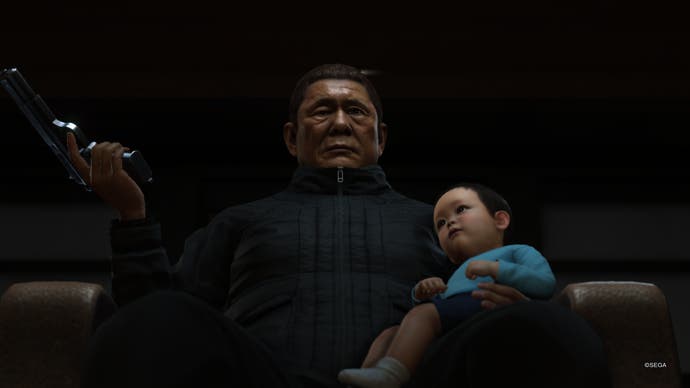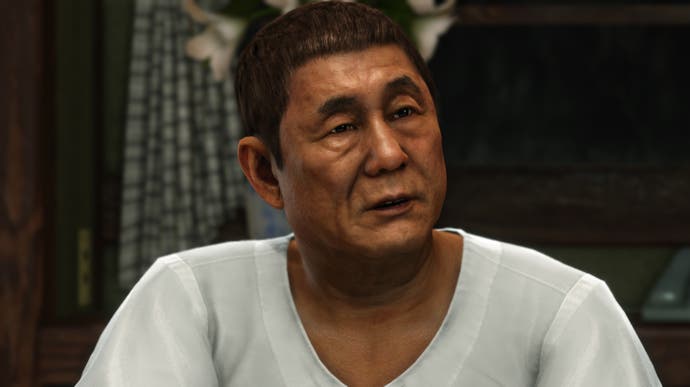Takeshi Kitano's legacy in video games
Beat that.
Video games have their fair share of auteurs, a term that's often applied to Japanese game developers like Shigeru Miyamoto, Hidetaka Miyazaki, Hideo Kojima, Shinji Mikami, Fumito Ueda and Yoko Taro. Their games not only have their unique distinct vision but have become widely influential.
One name we should also include, however, is Takeshi Kitano.
Better known by his stage name Beat Takeshi in Japan, Kitano rose to prominence in the 70s as a comedian. He later crossed over into film with his international debut as a sadistic prison officer in the 1983 Japanese POW drama, Merry Christmas, Mr Lawrence, before becoming a filmmaker in his own right with directorial debut, Violent Cop.
But among his wide variety of credits, you could also say that he was a one-time game developer too.
Released for the Famicom in 1986, Takeshi no Chōsenjō (or Takeshi's Challenge), which Kitano served on as a consultant and designer, had you playing as a poor salaryman who embarks on a treasure hunt on a remote island. In order to get there, however, you're also supposed to liberate yourself by breaking a bunch of social taboos, which includes beating up an old man in order to get the treasure map in the first place, divorcing your wife and resigning from your job.

While it certainly sounds innovative on paper in the way it combines arcade action with narrative adventure games and even GTA-style indiscriminate violence, it was also a ridiculously and deliberately impossible game to beat, most infamous in the way it incorporated the use the Famicom's microphone on the second controller for sections at a karaoke bar.
The first game to be awarded Famitsu's 'kusoge' (shit) ranking and considered one of the worst games of all time, it did have the same fate as E.T, however, somehow still selling over 800,000 copies, according to developer/publisher Taito. It has even been re-released on Wii's Virtual console and for mobile.
Granted, not much of a legacy in games, especially from someone who seems to have been deliberately trolling the medium - or was also apparently getting sloshed on rice wine at the time, if the stories are to be believed. That said, you could argue that this put Kitano light years ahead of the subversive indies who specialise in anti-game games or 'unfun' gameplay. At the same time, with the way you're frequently accosted by yakuza or indulging in weird mini-games, you could also say Takeshi no Chōsenjō was a precursor to the Yakuza games.
Indeed, Kitano has long been fascinated with yakuza, believing his own father might have been a member, while having spoken in past interviews about how, when growing up in a working class neighbourhood, the kids looked up to baseball players and yakuza.

Leaning into his violent tough guy persona, perhaps to deliberately shock audiences who had been more used to laughing at him on TV, he became known to an international audience with his 'yakuza trilogy' in the early 90s, although it was 1997's Hana-bi that really put him on par with other legendary Japanese filmmakers like Akira Kurosawa and Yasujiro Ozu.
Playing a retired cop, Kitano is a man of few words who better expresses himself with bouts of brutal violence against the yakuza gang repeatedly extorting him for the money he owes them. But this is also balanced with the care he shows to his terminally ill wife and the widow of a colleague killed in the line of duty. It's a nihilistic crime film that also shows the humour and humanity of his characters.
Kitano's deft skill of being able to make serious, meditative dramas yet still play the clown on TV shows makes his casting in Yakuza 6: The Song of Life pretty much perfect for a series that's always balanced serious drama with absurd comedy.
As a seemingly laid-back patriarch who treats the members of his yakuza subordinates like his own children, Hirose was clearly a character written for Kitano, and the Dragon Engine faithfully captures his tough-and-tender likeness. He first greets Kiryu while enjoying an ice cream sundae, boasting about his recent exploit of scamming a hospital for insurance money. Yet his playful demeanour hides the fact that he's actually got skills as a knife-wielding assassin and he ends up being one of Kiryu's deadliest opponents. Kitano naturally plays both sides of Hirose with brilliant understatement, making for one of the most nuanced performances in the series.
While Yakuza 6 might be Kitano's first official contribution to video games in 30 years (the game first released in Japan in 2016, though more audiences are now able to enjoy it thanks to its addition to Game Pass), I think his influence can also be felt elsewhere.
Take Ghost of Tsushima. Sure, Sucker Punch may say the team was inspired by the samurai films of Kurosawa, going as far as employing a 'Kurosawa mode' - as if the man didn't make films in colour (Ran is arguably his greatest masterpiece).
But I never really thought of Kurosawa as I was playing a vengeful, bloodthirsty Jin, but rather Kitano's 2003 revival of the famous blind samurai Zatoichi - incidentally the film that first introduced me to his work. Here these fights revel in extreme levels of blood-letting in stark contrast to the sharp rebuke given after the famous climax of Sanjuro. Meanwhile, the slow pensive samurai showdowns that end swiftly and brutally serve as a greater inspiration of Ghost of Tsushima's stand-offs.
However, to really appreciate Kitano's wider legacy on games, we have to go back to 1986 when, alongside Takeshi no Chōsenjō, Japan also began broadcasting Takeshi's Castle. As the host, the game show had Kitano playing a count of a castle, which saw over a hundred contestants competing in ridiculously muddy obstacle course-type challenges, their numbers whittling down with each round until the final remaining challengers attempt to storm the castle.
While clips of the show would occasionally turn up in the West on late night TV to highlight examples of wacky and weird Japan, it wasn't until the early 00s when it was condensed and repackaged for Challenge that it would become a cult hit, going on to inspire copycat shows like Total Wipeout.
The bigger inspiration here in games is, of course, Fall Guys, the online multiplayer game where up to 60 bean-shaped contestants compete in multiple rounds with one crowned champion at the end. Granted, there's also inspiration from older UK game shows like It's a Knockout, which specifically had contestants dressing up in oversized foam outfits, but Takeshi's Castle was always an explicit example cited by developer Mediatonic. One of the pitch slides included a GIF of the show, and Door Dash is directly lifted from the Knock Knock round.
It's not just Fall Guys though, because while some critics would cite the game as an example of a battle royale (or bumble royale) that subverts the original genre's violent combat, they're sort of getting it the wrong way round. Seeing as Takeshi's Castle originated in the 80s, its format of contestants being eliminated over the course of the show arguably makes it the original battle royale, preceding the book Battle Royale and its film adaptation by over a decade.
The links between the two may initially seem quite remote, the latter forcing school children to fight each other to the death, making it a subject of controversy in Japan, at a time when youth violence was beginning to be a societal concern. Yet to have Kitano, the host of Takeshi's Castle, cast as the ruthless teacher overseeing the battle royale (his character is also given the same name) is clearly no coincidence.
These days, Kitano is still a regular presenter on Japanese TV, but if reports are accurate, his upcoming samurai film Kubi may also be his last as director. While fans and critics will no doubt take that as an opportunity to look back on his achievements, his contributions to video games shouldn't be left out - they're actually more significant than you'd imagine.












